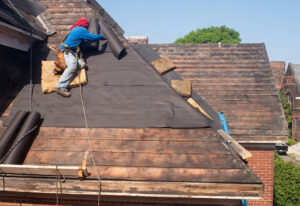Do you own a home or business that needs a new roof? You may be shocked at the price and wonder why are roofs so expensive. Knowing what drives these costs can help you better understand the roofing business and make the right choices about your next roof.
The roof protects a home or commercial building from all kinds of weather. The roofing material quality and installation skills directly affect the roof’s longevity. In this article, we’ll break down the various factors driving up roofing costs and help you understand the value behind your new roofing options. First, let’s address the main question.
Why Are Roofs So Expensive?
To answer this question, we can separate roof costs into four categories:
- Roofing Materials: High-quality roofing materials are more expensive than traditional asphalt shingles. These materials include TPO (thermoplastic polyolefin), EPDM (ethylene propylene diene monomer), and metal. They offer greater durability and longer lifespans.
- Labor: The installation process requires skilled labor. Labor estimates to install asphalt shingles run between $200 and $350 per 100 SF. Expect costs to double for installing metal, slate, or commercial roofing systems.
- Installation Complexity: Larger and more intricate roofs require more time and resources, further driving up expenses.
- Regional Variations: Costs can vary based on geographic location, influenced by local labor rates, building codes, and climate conditions.
A roof is an investment in the property. You must balance the quality of the roof you want with your budget. Let’s review the cost factors in more detail.
Factors Affecting Roofing Costs
The roofing material you select affects the overall cost of your roofing project. Premium materials, such as slate, metal, or high-end asphalt shingles, are much more costly than asphalt shingles.
Material Quality
Here’s the comparison between these two types of materials.
| Premium vs. Standard Materials | ||
| Description | Premium Materials | Standard Materials |
| Durability and Longevity | Lasts 40-100 years (e.g., metal, slate) | Lasts 15-30 years (e.g., asphalt shingles) |
| Energy Efficiency | High (e.g., reflective metal, TPO) | Moderate (e.g., asphalt shingles) |
| Installation Requirements | Requires specialized installation | Easier to install |
| Maintenance Needs | Low maintenance (e.g., metal, EPDM) | Higher maintenance (e.g., asphalt shingles) |
| Price Range per Square Foot |
|
|
The choice between premium and standard materials will depend on the building’s architectural style, local codes, personal preferences, and budget. Weigh the cost against the long-term durability and aesthetic appeal of the roofing material before making your decision.
Labor Costs
Roofing contractors bill for their time and skill, with rates differing based on the job’s complexity, local market conditions, and the crew’s level of experience. Elements such as the roof’s size, its pitch, and how accessible the work area will influence labor costs.
Additionally, the cost of specialized equipment, such as scaffolding or cranes, will increase the expenses of your roofing project.
Roof Installation Complexities
Factors such as the roof’s shape, the number of penetrations (e.g., chimneys, skylights, vents), and the need for specialized techniques or materials will increase the overall expense. For example, a simple gable roof is less costly to install than a complex, multi-faceted roof with multiple openings of the same size.
Winter weather adds to the complexity, making the work more hazardous and time-consuming. Installing a bulk material warmer onsite will keep roofing tar and asphalt shingles warm and pliable. If you plan to have roofing done during the winter months, this cold-weather roofing calculator can help you estimate the costs. You can find other tips for winter roof repair in our blog.
Let’s look at the different kinds of residential and commercial roofing systems out there and how their features can impact the costs.
Types of Roofs and Installation Challenges
Your building will have one of these types of roofs.
- Gable Roof: Relatively straightforward and less expensive to install.
- Hip Roof: More complex, with four sloping sides, which can increase labor and material expenses.
- Flat Roof: Requires specialized installation techniques and materials, often resulting in higher labor and materials.
- Mansard Roof: Combines vertical and sloped surfaces, adding to the complexity and cost of installation.
Another cost factor is whether you are replacing the current roof or constructing a new roof.
Roof Replacement vs. New Roof Installation
The difference here is pretty obvious. A new roof requires the construction of the entire roofing system, including rafters, joists, ridge, and decking. A replacement roof requires only the top layer of shingles or other roofing material.
A replacement roof will cost much less than constructing a new roof.
Now that we have covered the factors contributing to roofing costs, it might also be helpful to address a few common questions.
Frequently Asked Questions Regarding Roof Expenses
-
How Much Should You Spend on a Roof?
The answer to this question will depend on the size of your roof, the roofing material, the complexity of the installation, and your budget. As a general guideline, a 2,000 sq ft roof replacement cost ranges from $9,500 to $20,000 for standard asphalt shingles. The average is $14,750.
-
What Kind of Roof is the Cheapest?
The cheapest roofing option is asphalt shingles. They are widely available, relatively easy to install, and generally cost between $3 and $6 per square foot, making them a more affordable choice.
-
What is the Most Expensive Roof to Install?
On the other end of the spectrum, the most expensive roofing option is slate or copper. Slate is a natural stone. It is highly durable and looks beautiful. Slate can cost anywhere between $15 to $30 per square foot or more to install. Other premium materials, such as copper, cost between $14 and $25 per square foot.
With these expenses in mind, is there a way to trim the roofing cost? The answer is yes.
Tips for Reducing Roof Replacement Costs
While the cost of a new roof can be significant, there are several ways to reduce the overall expenses:
Seasonal Discounts and Deals
Roofing contractors often offer seasonal discounts or promotional deals, especially during the off-season. Time your project to take advantage of these cost-saving opportunities. To help you, download the winter roofing spec sheet.
DIY vs. Professional Roofing
For some homeowners, a do-it-yourself (DIY) roofing project may be a viable option, potentially resulting in significant cost savings. However, unless you have the right tools and skills, it’s not a good idea.
Instead, try one of these ways to reduce your roofing project cost.
Innovative Solutions for Cost Savings
Try one or more of these four cost-saving solutions:
1. Bulk Material Warmers
These warmers can maintain optimal temperatures for roofing materials, such as shingles and adhesives, in cold weather conditions.
Cost Savings: Keeping the materials at a workable temperature reduces material waste, crew downtime and labor costs.
2. Energy-Efficient Roofing Materials
Opting for energy-efficient materials, such as reflective roofing membranes or insulated panels, can significantly reduce the heat and cold transmission through the building’s roof.
Cost Savings: These materials help lower heating and cooling expenses by improving thermal performance. Lower energy bills can offset the investment in higher-quality materials.
3. Advanced Project Management Software
Utilizing software tools for project management can streamline operations, improve communication, and enhance scheduling.
Cost Savings: By optimizing workflows and reducing miscommunication, roofing companies can minimize labor costs and avoid costly delays. Efficient project management can also contribute to improved resource allocation, ensuring efficient use of materials and labor.
4. Pre-Planning and Design Optimization
Thorough pre-planning and utilizing design optimization techniques can help avoid potential issues before they arise. Start with a comprehensive list of necessary roofing tools.
Cost Savings: By addressing design flaws or logistical challenges early in the project, roofing contractors can avoid expensive change orders and rework. This proactive approach can lead to smoother execution and reduced overall project costs.
By investing in technology and quality materials, a roofing contractor can improve their bottom line while delivering high-quality results at affordable prices.
Real-Life Examples of Roofing Costs
No two roofs are identical, so estimating must account for up to 15 variables. This video explains all the variables to estimate the actual cost of repairing a roof.
One costly element, often missed in the quote, is waste management. Cedar roofs, roofs with multiple layers or complex roofs require multiple dumpsters to haul the old roofing away. This additional waste adds thousands of dollars to the cost.
Insurance companies often undervalue the cost of roofing projects. In one case, a country club in Argyle, Texas, sustained hail damage. The insurance company undervalued the claim at $176,501. After a licensed contractor reviewed the situation and resubmitted the claim, the insurance company paid the corrected amount of $387,203.
When choosing a roofing material, consider the building’s longevity and how long you plan to own the property. You must replace an asphalt shingle roof about every 15 years. However, a slate roof can last a century or more, and metal roofs can last up to 80 years.
When planning a budget for roofing work, it’s essential to understand local market conditions and specific project requirements.
Understanding the Complexities of Roofing Costs
The cost of roof replacement relies on various factors, including the type of roofing materials, labor expenses, and installation complexities. Whether you’re a homeowner or a commercial property manager, being aware of the factors that contribute to roofing expenses can help you confidently budget and plan for your next roofing project.
To enhance your roofing experience, explore bulk material warmers. This ideal solution keeps your roofing supplies warm, ensuring they are always ready to use and helping you save on wasted products.
Frequently Asked Questions
Why are roofs so expensive now?
Roofs are currently expensive due to significant price hikes in essential materials like asphalt, metal, clay, and slate, driven by increased demand, supply chain disruptions, and global market fluctuations.
How much should you spend on a roof?
The cost of a roof can range from $4,500 to $10,000 per thousand square feet, with an average cost of around $7,000, depending on the materials and complexity of the installation.
What is the least expensive way to roof a house?
The least expensive roofing option is asphalt shingles, which are widely available, easy to install, and cost between $3 and $6 per square foot.
The Powerblanket Hot Box is the ideal solution for keeping your roofing supplies warm, ensuring they are always ready to use, and helping you save on the cost of wasted products.



